Early Verdict
Packed with features and power, this portable PC is a strong sophomore release for Acer's Predator gaming lineup.
Pros
- +
Diminutive size
- +
Packed with power
- +
Sharp looks and handy features
Cons
- -
Pricey
Why you can trust TechRadar
Acer has been pushing hard to get into the PC gameing world with two powerful and feature packed desktops. However, both the Predator G3 and Predator G6 fell flat in our book with underwhelming upgradability and unfinished interiors unfitting for their premium asking price.
Now with a year of experience under its belt, Acer has taken all it lessons since reviving the Predator line to develop the Predator G1; a new gaming PC that squeezes more performance into a tighter package, all while looking even more attractive to boot.
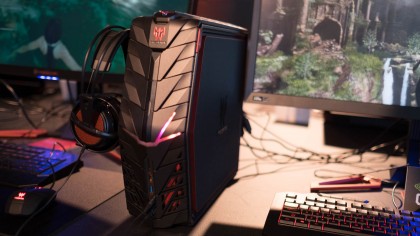
Design
While Acer's last few desktops resembled bloated mid-towers in the shape of a futuristic tank treads, the G1 is a more reserved take on the alien-like design. The case is considerably smaller, measuring it at only 4.49 x 13.70 x 16.46 inches (114 x 348 x 418 mm, W x D x H). It falls in line with Mini-ITX desktops like the Alienware X51, however, it isn't as small as the incredibly compact as the Asus ROG G20BM.
The Predator G1 inherits much of its design from Acer's first pair of desktops, however, the chevron fins have been sharpened and arranged into a spine of spades.
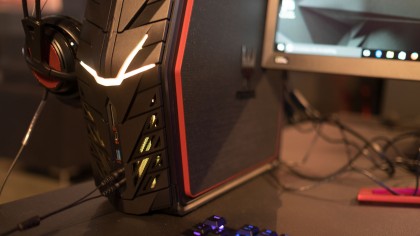
At the same time, Acer has bumped up the number of lighting effects. The front of case features an Ultraman-like crest of light and underneath that is a small, slanted grill area that allows glowing patterns to flow through.
Users will be able to customize the light patterns and how quickly they flow as well as color shifting. All together, the Acer Predator G1 offers a bigger light show than an episode of Power Rangers.
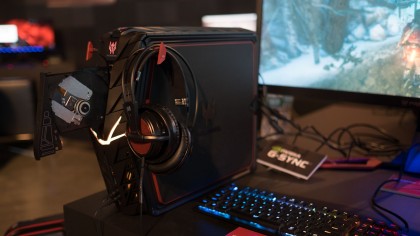
Fans of the shapeshifting G6 and G3 will be happy to know Acer's latest desktop retains some of the same handy and stealthy features. Despite the G1's compact size, it comes packing a vertically oriented disk drive that spits its tongue out sideways.
On either side of the device is also not one, but two pull out racks you can hang a gaming headset and virtual reality headset from.
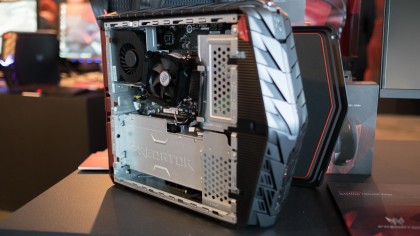
Specifications
Of course, there's more to a gaming desktop than a shiny exterior. The Predator G1 packs plenty of power into its 16-liter shell including Intel Core i5 and i7-series processors as well as enough room (and supporting wattage) for a Nvidia Titan X graphics card.
Internally, Acer has done a much better job with keeping the Predator G1 nice and clean. While the inside of the previous Predator PCs came with rat's nest of cables, there isn't a single wire in sight when you open up the G1.
In fact, the new mini tower features specially made metal panels hide the unsightly riser cards connecting the GPU to the motherboard and other components such as storage drives.
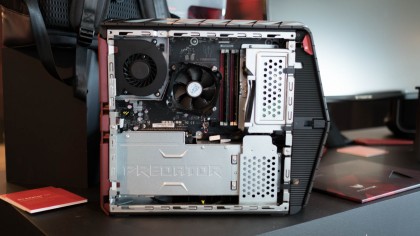
The only thing you won't find packed into this mini PC is the power supply. While you might think the fan tucked into the rear of the case is the PSU, it's actually an additional fan to help cool the desktop's internals. Electricity is delivered to the unit through two notebook-equivalent external power supply units that plug into the back of the PC through the motherboard.
The pre-production model I saw at Acer's global press conference didn't include thumbscrews or another form of tool-less access However, the Taiwanese electronics firm promises it's still working on making the final production model easy to upgrade.
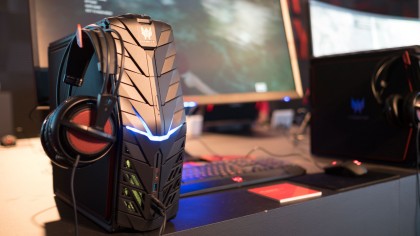
Early verdict
The Acer Predator G1 looks to be a promising little power box. It packs plenty of Acer's signature clever features including headset hangers and a hidden disk drive, plus a sharper and smaller case to boot. The lighting effects aren't exactly novel, but they give the G1 an added appeal.
Acer has really cleaned up its work internally and made clever use of the space it has by moving the power supply out. This miniature VR-ready is looking to be a real winner, but with a starting price of $2,299 or €1,199 (about £1,606, AU$2,970) I'll have to see if this machine can really fly before I can recommend it wholeheartedly when it releases later this July.
Kevin Lee was a former computing reporter at TechRadar. Kevin is now the SEO Updates Editor at IGN based in New York. He handles all of the best of tech buying guides while also dipping his hand in the entertainment and games evergreen content. Kevin has over eight years of experience in the tech and games publications with previous bylines at Polygon, PC World, and more. Outside of work, Kevin is major movie buff of cult and bad films. He also regularly plays flight & space sim and racing games. IRL he's a fan of archery, axe throwing, and board games.
What is a hands on review?
Hands on reviews' are a journalist's first impressions of a piece of kit based on spending some time with it. It may be just a few moments, or a few hours. The important thing is we have been able to play with it ourselves and can give you some sense of what it's like to use, even if it's only an embryonic view. For more information, see TechRadar's Reviews Guarantee.

